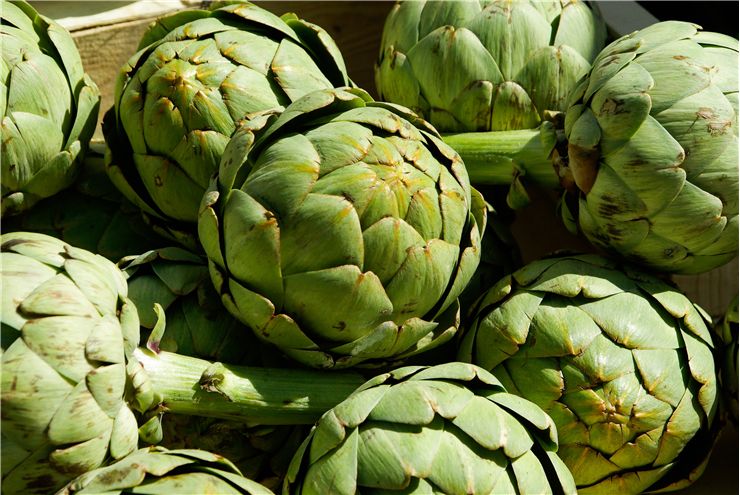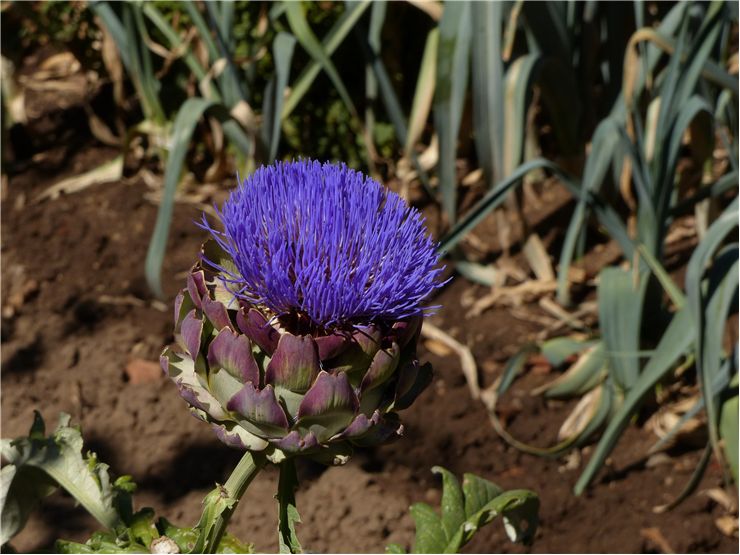Artichoke History - Different Artichoke Varieties
Artichoke (also called “globe artichoke”) is a type of thistle that we, in time, cultivated so we can use it for food. We eat its flowers while they are still buds. This perennial plant grows around the world, and it can grow up to 2 meters in height with leaves up to 80 cm long. Plant grow a flower-head which has smaller flowers on an edible base. Buds of these flowers are green or green-purple, can grow up to a 15 cm in diameter and have fleshy lower portions which are edible.
Artichoke's ancestor before the cultivation, cardoon, first appeared in Mediterranean was used as food by the ancient Greeks and Romans. They can still be found in North Africa. Seeds of the cultivated variants of cardoon were found in Mons Claudianus in Egypt, a quarry from the time of the ancient Rome. Ancient Greeks cultivated them on Sicily and called them “kaktos.” Further cultivation was performed at Naples in the 9th century, and in Muslim Spain and the Maghreb (a region in Northwest Africa, near Egypt) in the medieval period. Notaries of the Avignon mention artichokes in the 16th century and talk about them as about luxury and aphrodisiac. At about the same time, the Dutch brought artichokes to England. New World saw artichokes for the first time in the 19th century. Today, greatest producers of artichokes are still in Mediterranean. The Greatest producer is Egypt, followed by Italy and Spain. Outside of Mediterranean, the biggest producer is Peru. In the U.S. of A, that is California, which is one of the places where artichokes were first brought. It produces almost all of the yield of the artichokes produced in The United States.

While both varieties (cultivars), wild forms and cultivated exist, the traditional cultivated varieties are more frequent in use.
Types of Artichokes
Traditional cultivars
Green, big
- Vert de Laon (France)
- Camus de Bretagne (France)
- Castel (France)
- Green Globe (USA, South Africa)
Green, medium-size
- Verde Palermo (Sicily)
- Blanca de Tudela (Spain)
- Argentina (Chile)
- Española (Chile)
- Blanc d'Oran (Algeria)
- Sakiz (Turkey)
- Bayrampasha (Turkey)
Purple, big
- Romanesco (Italy)
- C3 (Italy)
Purple, medium-size
- Violet de Provence (France)
- Brindisino (Sicily)
- Catanese (Sicily)
- Niscemese (Sicily)
- Violet d'Algerie (Algeria)
- Baladi (Egypt)
- Ñato (Argentina)
- Violetta di Chioggia (Italy)
Spined
- Spinoso Sardo e Ingauno (Sardinia)
- Criolla (Peru)
White
- various places of the world
Cultivars by seeds
Artichokes for industry
- Madrigal
- Lorca
- A-106
- Imperial Star
Green
- Symphony
- Harmony
Purple
- Concerto
- Opal
- Tempo

Artichokes can be prepared in a variety of ways. When people cook them, they boil or steam them. Before that, the stem is cut but the last 5 to 10 mm. Thorns from the tops of the leaves of the bud (scales) are removed by cutting the top quarter of the scale. After that artichoke is boiled in water with added salt and uncovered, so, they don't turn brown due to the chlorophyll oxidation and enzymatic browning. This can also be prevented by adding vinegar or lemon juice to water. Artichoke can also be prepared by removing all the scales one by one and then boiling them Artichoke prepared like this is often eaten with hollandaise, vinegar, butter, mayonnaise, lemon juice, or other sauces.
Greek cuisine called “aginares a la polita” is a stew made of artichoke hearts, potatoes, carrot, onion, lemon, and dill. Another method of preparation is to remove the scales but leave the concave heart of the artichoke. Scales are then used for side dishes while the concave heart is filled with meat and fried or baked in a savory sauce. In Italy, artichokes are often stuffed with bread crumbs, garlic, oregano, parsley, grated cheese, and prosciutto or sausage. In Spain, young artichokes are prepared by sauteing them in olive oil with garlic and serving them with rice as a paella or mixed with eggs in a tortilla. People of the Da Lat region of Vietnam make herbal “Artichoke tea” and it can be even bought as a commercial product. “Alcachofa” is an artichoke herbal tea made in Mexico. Taste of these teas is bitter and “slightly woody”. Even a liquor can be made from artichokes. Italian liqueur Cynar has 16.5% of alcohol and is served over ice as an aperitif or as a cocktail with orange juice. This cocktail is very popular in Switzerland.
Artichoke is an excellent antioxidant. It also aids digestion, liver function, and gallbladder function.

